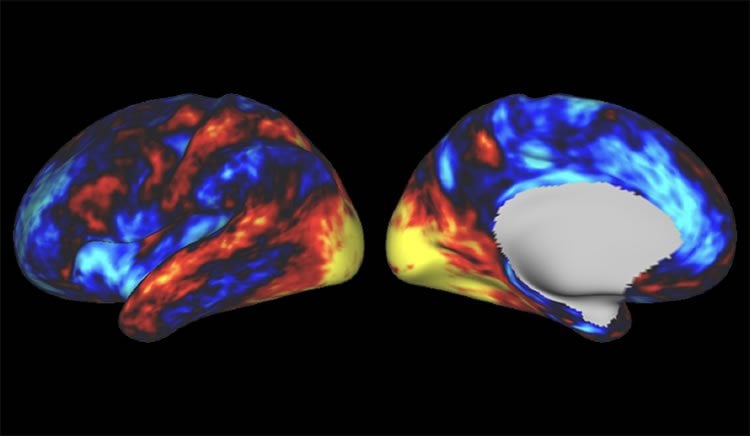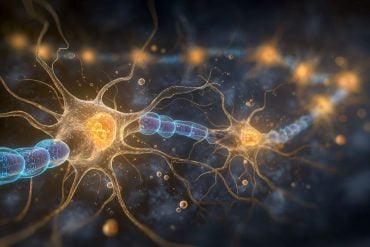Summary: Researchers report LSD triggers a reduction in functional connection between areas of the brain that govern cognitive processes, while increasing connectivity in brain networks associated with sensory functions.
Source: Yale.
Psychedelic drugs such as LSD have a profound impact on human consciousness, particularly perception. Researchers at Yale and the University of Zurich provide new insight into the psychedelic effects of LSD on the brain and potential therapeutic uses of the drug.
The new data indicate that LSD triggers a reduction of functional connections between regions of the brain governing cognitive processes and increases connectivity in brain networks associated with sensory functions. It does so by stimulating a particular receptor for the neurotransmitter serotonin (serotonin-2A or 5HT2A receptor). The 5HT2A receptor has been implicated in the regulation of mood and cognition.
Using gene expression maps and data-driven tools to measure brain-wide communication, the team was able to infer the patterns of brain signals in subjects who had taken LSD and identify the 5HT2A receptor as a crucial mechanism leading to changes in perception and thought.
“There is a net effect of LSD on the entire brain but the effect is not uniform,” explained Alan Anticevic, assistant professor of psychiatry and psychology and co-senior author of the paper, which appears in the journal eLife.
In recent years, scientists have become increasingly interested in the use of psychedelics to treat mental health disorders such as depression. While serotonin plays a key role in maintaining mood balance and decreased levels are associated with depression, another immediate impact of the new findings may be in the treatment of schizophrenia, Anticevic suggested.
Most schizophrenia patients are treated with atypical antipsychotic drugs, which block some of the serotonin receptors identified by the new study. However, many patients don’t respond well to such treatments.
“Clinicians may be able to identify individual patients most likely to benefit from these drugs by looking for similar patterns of brain activity identified in the study,” noted Katrin Preller, assistant professor at the University of Zurich and visiting professor at Yale, who is the lead author of the paper.
Using a technology optimized by Anticevic and Dr. John Murray, assistant professor of psychiatry at Yale and co-author on the paper, researchers pinpointed gene activity in the brain and showed how it influences neurotransmitter function.

In the 1960s, Yale researchers Daniel X. Freedman, Nicholas Giarman, and George Aghajanian first implicated the serotonin system, and the 5HT2A receptor, in the actions of LSD, noted Dr. John Krystal, professor and chair of psychiatry at Yale.
“It has taken over 50 years and technical advances in brain imaging and molecular neuroscience to enable us to build on the earlier work in mechanistic clinical research,” Krystal said. “This path, and other related research strategies will take us deeper in our search for the roots of human consciousness and the biology of mental illness.”
Funding: Swiss National Science Foundation (SNSF, P2ZHP1_161626, KHP), the Swiss Neuromatrix Foundation (2015 – 0103, FXV), the Usona Institute (2015 – 2056, FXV), the NIH (R01MH112746, JDM; DP5OD012109, AA; R01MH108590, AA), the NIAA ( P50AA012870-16, AA & JHK), the NARSAD Independent Investigator Grant (AA), the Yale CTSA grant (UL1TR000142 Pilot Award, AA), and the Slovenian Research Agency (ARRS J7-6829 & ARRS J7-8275, GR).
Source: MBill Hathaway – Yale
Publisher: Organized by NeuroscienceNews.com.
Image Source: NeuroscienceNews.com image is credited to Katrin Preller & Alan Anticevic.
Original Research: Open access research for “Changes in global and thalamic brain connectivity in LSD-induced altered states of consciousness are attributable to the 5-HT2A receptor” by Katrin H Preller, Joshua B Burt, Jie Lisa Ji, Charles H Schleifer, Brendan D Adkinson, Philipp Stämpfli, Erich Seifritz, Grega Repovs, John H Krystal, John D Murray, Franz X Vollenweider, and Alan Anticevic in eLife. Published October 26 2018.
doi:10.7554/eLife.35082
[cbtabs][cbtab title=”MLA”]Yale”How LSD Changes Perception.” NeuroscienceNews. NeuroscienceNews, 26 October 2018.
<https://neurosciencenews.com/lsd-perception-10094/>.[/cbtab][cbtab title=”APA”]Yale(2018, October 26). How LSD Changes Perception. NeuroscienceNews. Retrieved October 26, 2018 from https://neurosciencenews.com/lsd-perception-10094/[/cbtab][cbtab title=”Chicago”]Yale”How LSD Changes Perception.” https://neurosciencenews.com/lsd-perception-10094/ (accessed October 26, 2018).[/cbtab][/cbtabs]
Abstract
Changes in global and thalamic brain connectivity in LSD-induced altered states of consciousness are attributable to the 5-HT2A receptor
Background:Lysergic acid diethylamide (LSD) has agonist activity at various serotonin (5-HT) and dopamine receptors. Despite the therapeutic and scientific interest in LSD, specific receptor contributions to its neurobiological effects remain unknown. Methods: We therefore conducted a double-blind, randomized, counterbalanced, cross-over study (ClinicalTrials.gov, NCT02451072) during which 24 healthy human participants received either (i) placebo+placebo, (ii) placebo+LSD (100 µg po), or (iii) Ketanserin, a selective 5-HT2A receptor antagonist,+LSD. We quantified resting-state functional connectivity via a data-driven global brain connectivity method and compared it to cortical gene expression maps. Findings: LSD reduced associative, but concurrently increased sensory-somatomotor brain-wide and thalamic connectivity. Ketanserin fully blocked the subjective and neural LSD effects. Whole-brain spatial patterns of LSD effects matched 5-HT2A receptor cortical gene expression in humans. Conclusion: Together, these results strongly implicate the 5-HT2A receptor in LSD’s neuropharmacology. This study therefore pinpoints the critical role of 5-HT2A in LSD’s mechanism, which informs its neurobiology and guides rational development of psychedelic-based therapeutics.






